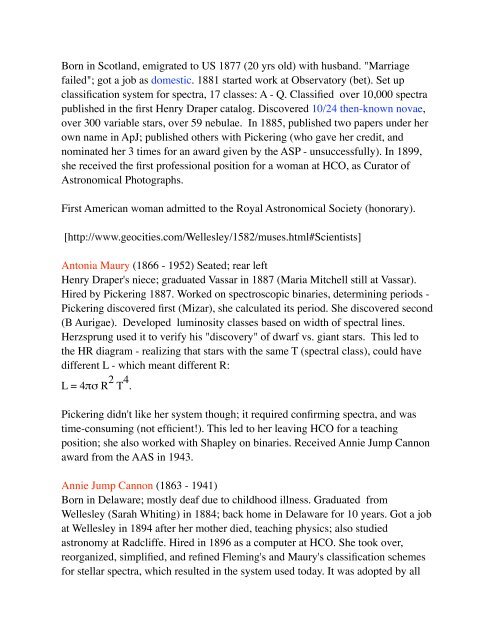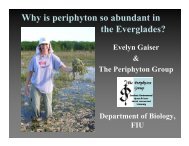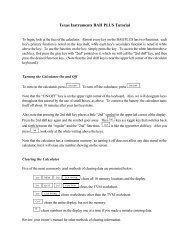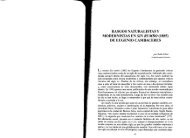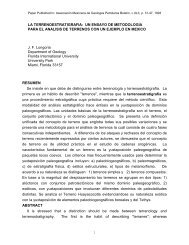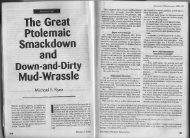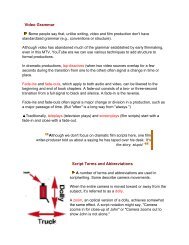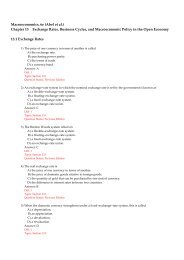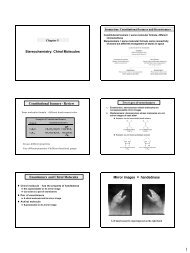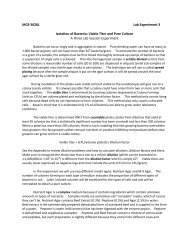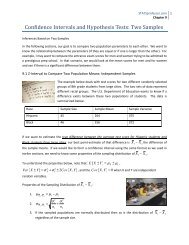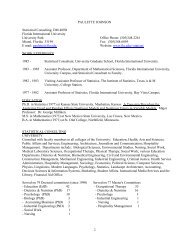Women in Astronomy En Hedu'Anna 2354 BC (Akkad/Sumer ...
Women in Astronomy En Hedu'Anna 2354 BC (Akkad/Sumer ...
Women in Astronomy En Hedu'Anna 2354 BC (Akkad/Sumer ...
You also want an ePaper? Increase the reach of your titles
YUMPU automatically turns print PDFs into web optimized ePapers that Google loves.
Born <strong>in</strong> Scotland, emigrated to US 1877 (20 yrs old) with husband. "Marriage<br />
failed"; got a job as domestic. 1881 started work at Observatory (bet). Set up<br />
classification system for spectra, 17 classes: A - Q. Classified over 10,000 spectra<br />
published <strong>in</strong> the first Henry Draper catalog. Discovered 10/24 then-known novae,<br />
over 300 variable stars, over 59 nebulae. In 1885, published two papers under her<br />
own name <strong>in</strong> ApJ; published others with Picker<strong>in</strong>g (who gave her credit, and<br />
nom<strong>in</strong>ated her 3 times for an award given by the ASP - unsuccessfully). In 1899,<br />
she received the first professional position for a woman at HCO, as Curator of<br />
Astronomical Photographs.<br />
First American woman admitted to the Royal Astronomical Society (honorary).<br />
[http://www.geocities.com/Wellesley/1582/muses.html#Scientists]<br />
Antonia Maury (1866 - 1952) Seated; rear left<br />
Henry Draper's niece; graduated Vassar <strong>in</strong> 1887 (Maria Mitchell still at Vassar).<br />
Hired by Picker<strong>in</strong>g 1887. Worked on spectroscopic b<strong>in</strong>aries, determ<strong>in</strong><strong>in</strong>g periods -<br />
Picker<strong>in</strong>g discovered first (Mizar), she calculated its period. She discovered second<br />
(B Aurigae). Developed lum<strong>in</strong>osity classes based on width of spectral l<strong>in</strong>es.<br />
Herzsprung used it to verify his "discovery" of dwarf vs. giant stars. This led to<br />
the HR diagram - realiz<strong>in</strong>g that stars with the same T (spectral class), could have<br />
different L - which meant different R:<br />
L = 4πσ R 2 T 4 .<br />
Picker<strong>in</strong>g didn't like her system though; it required confirm<strong>in</strong>g spectra, and was<br />
time-consum<strong>in</strong>g (not efficient!). This led to her leav<strong>in</strong>g HCO for a teach<strong>in</strong>g<br />
position; she also worked with Shapley on b<strong>in</strong>aries. Received Annie Jump Cannon<br />
award from the AAS <strong>in</strong> 1943.<br />
Annie Jump Cannon (1863 - 1941)<br />
Born <strong>in</strong> Delaware; mostly deaf due to childhood illness. Graduated from<br />
Wellesley (Sarah Whit<strong>in</strong>g) <strong>in</strong> 1884; back home <strong>in</strong> Delaware for 10 years. Got a job<br />
at Wellesley <strong>in</strong> 1894 after her mother died, teach<strong>in</strong>g physics; also studied<br />
astronomy at Radcliffe. Hired <strong>in</strong> 1896 as a computer at HCO. She took over,<br />
reorganized, simplified, and ref<strong>in</strong>ed Flem<strong>in</strong>g's and Maury's classification schemes<br />
for stellar spectra, which resulted <strong>in</strong> the system used today. It was adopted by all


